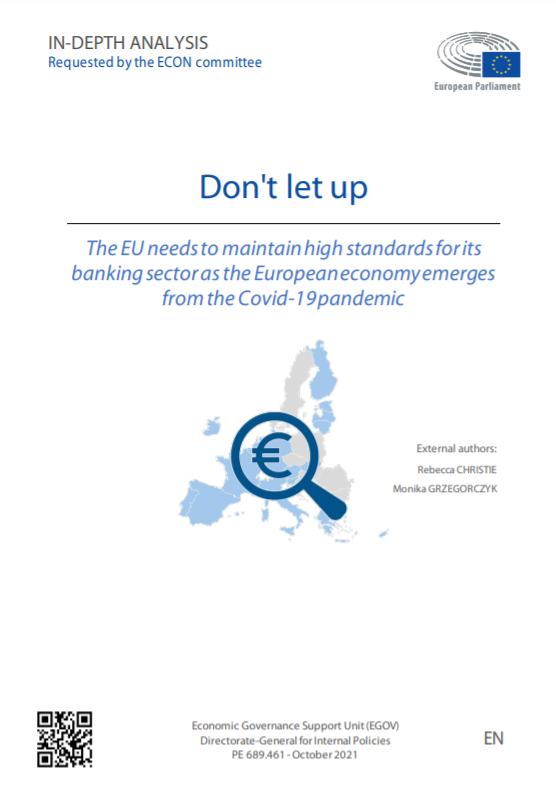Blog Post
European bank mergers: domestic or cross-border?
As the European economy recovers from the global financial crisis, bank mergers are back on the agenda. While cross-border mergers have been predicted before, most European bank mergers have been domestic until now. What are the odds of cross-border mergers in the upcoming bank-consolidation wave?
European bank mergers are back on the agenda: UniCredit and Société Générale are reported to be exploring a cross-border merger and Barclays is looking at a possible domestic merger with, or acquisition of, Standard Chartered.
There are two trends behind a prospective bank consolidation wave in Europe, which was predicted with the move to the banking union. The first trend is cyclical: the European economy is in recovery mode and bank balance sheets in most EU countries have been cleaned up. As a result, bankers start to plan for the future. The second trend is structural: there is an overreliance on banking in Europe (Langfield and Pagano, 2016); the shift from banking to capital markets has already set in.
Figure 1 shows the share of banks and institutional investors (investment funds, insurers and pension funds) in the euro area (EA). The share of institutional investors, who operate in capital markets, in total EA financial intermediation has already increased from 30% to 40%.
Banks are thus consolidating to reduce overcapacity. Since withdrawal is near impossible in the regulated and protected banking sector, mergers and acquisitions are the main mechanism for bank consolidation.
The big question is whether the prospective merger wave will be domestic or cross-border. On the one hand, when cross-border consolidation has previously been predicted to follow integration events (such as the Single Market in 1993 and the Economic and Monetary Union in 1999) the major mergers remained domestic (Schoenmaker, 2015).The merger of ABN and AMRO in 1991 and the creation of the BNP Paribas Group from the merger of BNP and Paribas in 1999 are examples of such domestic banking mergers. By contrast, the lifting of the ban on cross-state mergers in the 1990s led to major cross-state consolidation in the United States (Stiroh and Strahan, 2003).
European banking market
Before reviewing the main drivers of cross-border and domestic bank mergers, we examine the European banking market. Table 1 indicates that the largest banks are headquartered in the UK, France, Germany and Spain. It also shows that the largest European banks already conduct substantial cross-border business. On average, domestic business accounts for 56% of total. The rest of their business is split, with 22% of business activities organised in the rest of Europe and the remaining 22% in the rest of the world. Of course, this fraction varies as there are some very international banks – like HSBC, Credit Suisse and Standard Chartered – as well as some more domestic banks – like Crédit Agricole and Lloyds Bank.
While many bank combinations can be imagined, supervisory authorities have become wary of large banks that are ‘too big to fail’ . This implies that supervisors are reluctant to allow mergers that create mega-banks with over €2.5 trillion-€3 trillion in assets. As a result, a merger among the top eight banks in Table 1 is likely to be blocked. That being said, one of the larger banks may take over a relatively smaller bank.
Cross-border mergers: the arguments in favour
A major synergy of cross-border mergers is credit risk diversification. In a recent paper, we found that cross-border mergers do not lead to higher returns, but do reduce credit risk (Duijm and Schoenmaker, 2017). This diversification effect is caused by limited synchronisation of business cycles across the EU. Indeed, our findings show that a bank active in two countries which expands its business into a third country experiences a reduction in default risk of close to 1.3%.
Nevertheless, banks cannot yet fully reap the benefits of cross-border integration since national supervisors are still ring-fencing liquidity and capital at the national level, thus limiting the benefits of banking union (Schoenmaker and Véron, 2016).
A second synergy of cross-border mergers is the scaling up of technological innovation. Major players such as ING Bank, Santander, and BNP Paribas invest heavily in new technologies (both developed within the bank and acquired by buying fintechs). These banks can subsequently roll out their new technologies across their domestic and international businesses.
Examples include the acquisition of Abbey National in the UK by Santander and the acquisition of the German Direktbank by ING (renamed to ING DiBa). In the case of Santander and ING, they used these foreign acquisitions to introduce their technological superiority in these markets. In this way, they created a strong competitive edge and generated a higher return on their technology investments through economies of scale.
A final argument for cross-border mergers is client-driven. The client-pull hypothesis (Grosse and Goldberg, 1991) states that a bank’s international clientele, notably large corporates, provides an incentive for a bank to pursue more initiatives on an international scale. Indeed, the financial system of the foreign country might lack a level of sophistication that these corporates desire. Furthermore, corporates want to concentrate their international business with only a few banks to streamline payments and to benefit from cash-pooling.
Domestic mergers
The driving force of domestic consolidation is cost savings through economies of scale. As mentioned before, during the previous integration episodes bank mergers were primarily domestic. Indeed, the ratio of domestic to cross-border bank mergers was five to one over the period 1990-2001 (Campa and Hernando, 2006). Before the global financial crisis, multiple domestic bank mergers took place within the EU and, as a result, the majority of EU countries experienced an increase in banking concentration from 1999 to 2007.
Using the concentration ratio of the five largest banks (CR-5), Table 2 indicates that over this period the average CR-5 increased by nine percentage points to 44.5% in 2007. When the crisis kicked in and the economy started stagnating, the merger activities automatically shrunk. Moreover, on average, the concentration ratios slightly decreased in the post-crisis period of 2010-2017.
After the global financial crisis and the transformation to digital banking (internet-driven payment technologies), banks have mainly been focused on closing branches and reducing their labour force to save on costs. From 2010 to 2017, almost all EU countries showed a significant decrease in the number of branches and employees per thousand inhabitants. Table 2 illustrates this remarkable decrease: from ratios of 0.44% and 7.8% respectively in 2010 to 0.35% and 6.7% in 2017. Hence, while prior to the global financial crisis the focus was on domestic bank mergers for efficiency gains, since then the focus has been on merging local branches within banks and on laying off the staff of these newly merged branches.
There are, however, differences between countries: Dutch, Finnish and Estonian banks are below the current averages. By contrast, however, Austrian, German and French banks have multiple branches and continue to hold large workforces, therefore placing them well above the average efficiency indicators.
Now that the European economy has reached the state of recovery, domestic bank mergers may reappear as a means of saving costs – effectively closing every second branch of the combined bank in the high street. There is, however, an important policy constraint: Domestic mergers will not be allowed in concentrated markets for competitive reasons. Furthermore, as indicated by the aforementioned CR-5 ratio, there are some countries that are already very concentrated with CR-5 ratios above 75%. These countries include small countries as well as Greece and the Netherlands.
Concluding remarks
There are several perks that encourage cross-border mergers, such as credit risk diversification and the scaling-up of IT investments. Moreover, European policymakers prefer cross-border mergers as they deepen financial integration (e.g. Nouy, 2017).
But it remains to be seen whether these cross-border synergies will be exploited, as earlier consolidation episodes were primarily domestic. Banking policies are not yet fully attuned to the new banking union setting. National supervisors still have some – albeit waning – influence. Moreover, deposit insurance is still national, which is important for consumers. Cultural barriers and different tax and legal systems may also hamper cross-border consolidation.
Gonçalves Raposo and Wolff (2017) show that little has changed in merger and acquisition activity since the Banking Union was launched. They even signal a slight re-nationalisation of banking consolidation. We consider the reduction of overcapacity in European banking as the strongest force. This suggests that domestic mergers realise further cost savings. Some of the larger banking markets in Europe, such as those in Germany, France and Austria, are still relatively inefficient and not yet concentrated. Thus, there is much scope for domestic consolidation.
References
Campa, J. M. and I. Hernando (2006), ‘M&As performance in the European financial industry’. Journal of Banking & Finance, 30(12): 3367-3392.
Duijm, P. and D. Schoenmaker (2017), ‘European Banks Straddling Borders: Risky or Rewarding?’, CEPR Discussion Paper No. DP12159.
Goncalves Raposo, I. and G. Wolff (2017), ‘How has banking union changed mergers and acquistions?’, Blogpost, Bruegel, 13 September.
Grosse, R. and L. G. Goldberg (1991), ‘Foreign bank activity in the United States: An analysis by country of origin’, Journal of Banking & Finance, 15(6): 1092-1112.
Langfield, S. and M. Pagano (2016), ‘Bank bias in Europe: effects on systemic risk and growth’, Economic Policy, 31(85): 51-106.
Nouy, D. (2017), ‘Too much of a good thing? The need for consolidation in the European banking sector’, Speech at the VIII Financial Forum, Madrid, 27 September.
Schoenmaker, D. (2015), ‘The new Banking Union Landscape in Europe: Consolidation Ahead?’, Journal of Financial Perspectives, 3(2): 189-201.
Schoenmaker, D. and N. Véron (2016), European Banking Supervision: The First Eighteen Months, Blueprint 25, Bruegel, Brussels.
Stiroh, K. and P. Strahan (2003), ‘Competitive dynamics of deregulation: evidence from U.S. banking’, Journal of Money, Credit, and Banking, 35(5): 801–828.
Authors’ note: The views and opinions expressed in this article are those of the authors, and this article is prepared in their personal capacity.
Republishing and referencing
Bruegel considers itself a public good and takes no institutional standpoint. Anyone is free to republish and/or quote this post without prior consent. Please provide a full reference, clearly stating Bruegel and the relevant author as the source, and include a prominent hyperlink to the original post.




















